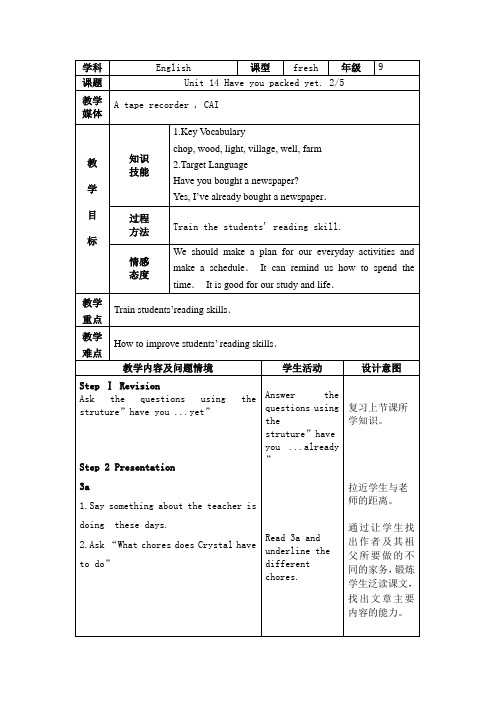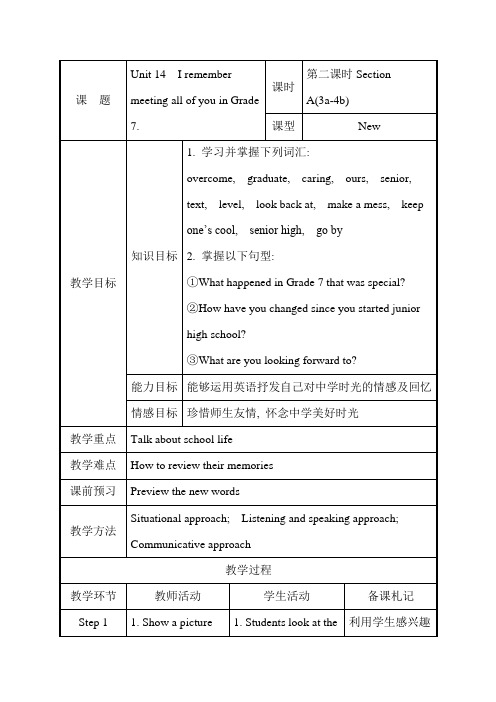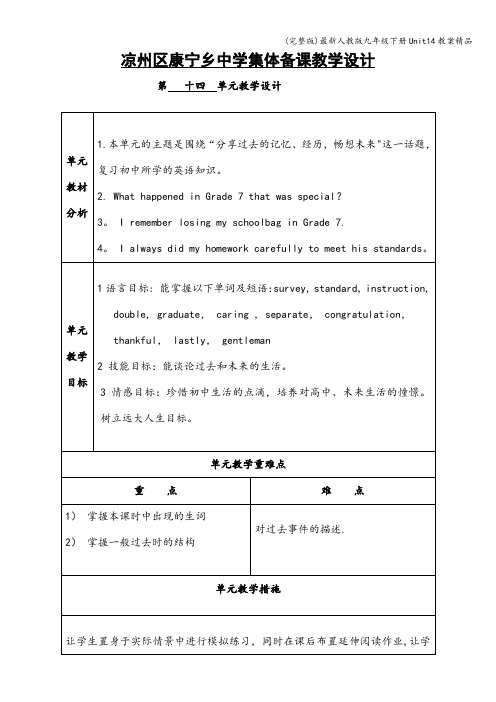人教新目标九年级英语第十四单元精品教案
- 格式:pdf
- 大小:1.17 MB
- 文档页数:5


Unit 14I remember meeting all of you inGrade 7.Period 1Section A 1a-2d【课型】听说课学习目标1.能掌握以下短语:do a school survey,score two goals in a row,take a break from running,my exam scores double2.能运用remember doing sth.这个句型描述令自己难忘的人和事。
学习过程【自主学习】1.回忆初中三年的学校生活,谈一谈你最难忘的事情有哪些?2.至少列出三件自己最难忘的事情。
【新课导入】师生问候。
了解本课学习目标。
谈论初中三年来最难忘的事情。
What are your special memories at your junior high school?.(1)I once won a prize.(2)I once was a volunteer.(3)I went to the mountains.(4)I visited museums....【新知呈现】看图片,听老师的示范,进入学习环节。
What do you remember doing at junior high school?Do you remember Mr.Wang?...【拓展提升】小组调查:询问其他成员最难忘的事,并向大家汇报。
句型:What do you remember doing at junior high school?【跟踪训练】1.Work on1a.Ask students to check the things they remember doing at junior high school.Add more to the list.2.Practice in pairs using the information in1a.3.汉译英(1)初中(2)结束(3)获奖(4)做志愿者(5)教学方法(6)记得做过某事(7)对……有耐心(8)无论(9)因为(10)得满分【课堂练习】根据2d对话,补全短文Clara said she would Ms.Lee and Mr.Brown the most junior high school,because Ms.Lee helped Clara to the answers herself how difficult they were and Mr.Brown always the time to things to her clearly she couldn’t anything.Judy said she would miss Ms.Griffin the most because she her in English class. her,she put in and her exam scores.课堂小结先自主学习,再以四人小组方式展开讨论:1.本课学习了哪些内容?2.还有什么疑问?组内讨论,解决不了的反馈给老师一起解决。


凉州区康宁乡中学集体备课教学设计第十四单元教学设计凉州区康宁乡中学集体备课教学设计编写时间: 2015年 4 月 20 日学期总课时:40凉州区康宁乡中学集体备课教学设计编写时间: 2015年4 月 20日学期总课时:41凉州区康宁乡中学集体备课教学设计编写时间: 2015年 4 月 20日学期总课时:42凉州区康宁乡中学集体备课教学设计编写时间: 2015年 4 月 20日学期总课时:43凉州区康宁乡中学集体备课教学设计编写时间: 2015年 4 月 20 日学期总课时:44凉州区康宁乡中学集体备课教学设计编写时间: 2015年 4 月 20 日学期总课时:45课题Unit 14 I remember meeting allof you in Grade 7. Period six课型新授课教学目标知识技能1、Grammar: remember doing sth.2、Words and expressions3、To know how to talk about the future by practicingand role-play.过程方法Task—based language teaching method情感态度价值观After l earning this part, every student will havea dream of his future career.教学重点Target Language教学难点To learn how to describe future careers.教学内容及教师活动二次修改Step 1 RevisionCheck homework.Step 2 Writing1。
Work on 3a。
Think of a person or an event from junior high school that you will never forget.Make some notes about how this person or eventchanged your life in some way。


Unit 14 I remember meeting all of you in Grade 7.说课稿(一)一.教材分析本节课是初中英语新教材第14单元的第一课时,本单元的核心话题为“talk about past memories and experience”,围绕着谈论过去三年的美好记忆及对未来的憧憬,以pair work,group work等训练方式和独立学习、合作交流、完成任务等形式完成目标语言的输入,学习remember的用法为主要学习任务,并且设置任务型综合性语言实践活动,让学生在交际活动中,学会如何正确地用英语表达的记忆及一些经历,重在培养学生的习得语言运用能力、实践能力、合作能力及创新意识。
二.学生情况分析通过两年的学习,九年级学生大多数已有了相对较扎实的英语功底,形成了自己学习英语的方法和习惯,本班大多数学生都能使用目标语言进行会话交流。
但由于九年级平时学习任务重,时间紧张,他们对英语的习趣和热情已不像七八年级那样高涨。
也有部分学生对英语失去了兴趣,但他们有较强的模仿和记忆能力,且对于新事物的接收能力比较强。
本节课要面向全体学生,对学生进行听说能力的训练和提高学生在任务中学习的能力,同时也要提高学生的应试能力。
三. 教学目标:1. 知识与技能目标:1) 分享学生们在过去三年的美好记忆及经历。
2)使学生掌握remember的用法。
2. 过程与方法通过使用一些旧照片及电子白板放映的图片唤起学生在过去三年的美好记忆,通过使用结对活动和小组活动完成我的教学目标。
3.情感态度价值观目标:让学生对于他们的未来有很好的规划,憧憬高中及大学的生活,完成他们的理想目标,让学生了解到同学间的友谊是无价的。
四、教学重难点1. 教学重点:说课稿 21)掌握本课时中出现的生词survey, row , keyboard, instruction, double.2) 分享初中三年的美好记忆及难忘的经历。
Unit 14 Have you packed yet?Section A 学案1.Listening 1b听并填上关键信息。
1) Listen for information:2) Listen for grammarWoman: ______________ you _____________the beach towels yet?Boy: ______________________. Can’t Judy pack them?Woman: No, she’s busy. Could you please water the plants?Boy: I_____________already ______________them.Woman: Oh, thanks.Man: What about the travel guidebook and the street map?Woman: I__________ already ______________ the travel guidebook, but I _____________the street map yet.Man: That’s OK. I’ll get it. __________ you ___________ the camera?Boy: Yup. _______________it in my suitcase.Woman: Well, I guess that’s everything.Boy: Almost everything. We___________________ the windows yet.语法归纳:现在完成时:构成:_____________________________________________用法:1. ___________________________________________2. ___________________________________________常用时间状语:_____________________________________2.Listening 2a, 2bBoy: Mom and Dad said they want to leave in ten minutes. Are you ready, Tina?Girl: No. I haven’t cleaned out the __________yet. I have to do that right now.Boy: Tina! You’re ______________. What about your bike?Girl:I’ve already put it in the garage. But I haven’t locked the garage yet. That’s your job, Mark.Boy: I know. I’ve already done most of my jobs. I’ve taken out the__________.Girl: Have you fed the cat yet?Boy: Not yet. I’ll do it in a minute. Have you turned off your radio?Girl: Yes, I have. I think we’re almost ready.3.Group work---Interview4.3a reading1) Fast reading questions:➢When did he start doing his homework?➢Has he finished his homework?➢Why hasn’t Crystal finished all those chores?➢How many chores did his grandfather have to do?2) Post-reading Writing回顾自己一周的学习和生活安排,列出一份时间安排表Timetable,显示自己是如何充分的利用时间的。
Unit14 I remember meeting all of you in Grade 7.教学目标:1. Knowledge ObjectsKey Vocabulary: gentleman, graduation, ceremony, first of all, congratulate, thirsty, be thirsty for, thankful, be thankful to sb.2.Ability ObjectsTo master the key words and target language.To train students’ reading comprehensive skills.To learn to share past memories and experiences and look ahead of the future.3.Moral ObjectsCultivate student’s expectation of the future.教学重难点:Teaching Key Points:Key vocabulary and target language.Develop students’ reading skills.Teaching Difficult Points:To learn to share past memories and experiences and look ahead of the future.教学准备:PPTStep1 .Leading in1. GreetingsGreet students as usual.2. Free talk.Talk about their memories at junior high, and future dreams.T: Do you know me ? When did you meet me ? Do you remember?T:You are going to graduate, what do you remember at junior high school?T: After graduation, what do you hope to do in the future?.T: Hope your dreams will come true.3. Discussion.What is the most important thing you have learned in junior high school? Discuss the question with a partner.Possible answers:1.How to deal with the difficulties.2.To learn from the mistakes and never give up.3.We should remember the important people in our lives who helped and supported us----our parents, our teachers and our friends.4.As you set out on your new journey , you shouldn’t forget where you came from.情感升华:it is more significant to learn to behave than master knowledge.学会做人可能比掌握知识更重要。
Unit14 I remember meeting all of you in Grade 7教学设计SectionA(3a-4b)Ⅰ.Teaching objectives 教学目标一.Language goals 语言目标Key Words and Sentence Structures1.overcome, caring, ours, senior, text, level, look back at, make a mess, keep one’s cool, senior high school, go by, have problems with, with one’s help, at the end of, look forward to, plan for2 Sentence structures1) It’s time to graduate. 2) I had problems with pronunciation and reading texts.3) This year, with Mr. Trent’s help, my English level has been improving and I hope to get good grades at the end of the year. 4) What are you looking forward to?二.Ability goals 能力目标1 To lead Ss to learn about the type and theme of a passage.2 To enable Ss to appreciate poem.三.Emotional goals 情感目标1 To guide Ss to share good memories end express feelings about junior school life.2 To arouse Ss’ love for school, friends and teachers3 To encourage Ss to set a goal for the futureⅡ.Important and difficult teaching points教学重难点1.Important teaching pointsTo enable Ss to understand and appreciate a rhyming poem.To enable Ss to feel the rhythm and stress of the poem and read it beautifully.2. difficult teaching pointsTo lead Ss to write about their memories and expressions in a poem style.Ⅲ.Teaching methods 教学方法situational teaching approach交际型教学question and answer method问答法Ⅳ.Teaching aids 教学辅助blackboard and chalk, computer , projector,Ⅴ.Teaching procedures 教学进程Step1. Lead-in and warming-up Activities1.Present some pictures about junior middle school life.2.Guide Ss to talk about their sweet memories using “remember doing ...”structure.【设计意图】通过展示图片,帮助学生回顾他们三年的初中生活,引起学生心底的共鸣,同时回忆上节课学习的内容,巩固句型的用法。
Step 2 . Reading Practice-阅读训练1.Pre-reading-读前导入Listen to a song called “You raise me up” and ask some questions.Q1: What do you want to say to your teachers?Q2: What do you want to say to your classmates?【设计意图】通过对一首经典老歌的欣赏,用师生问答的形式,引发学生对心底记忆的挖掘,使他们进入本节课的情感氛围。
活跃课堂气氛,让尽可能多的学生动起来,迅速进入到上课状态。
2.While-reading 读中理解(1) Fast Reading : please read the passage quickly and answer the two questions.Question 1: What kind of writing is this? It’s a poem.Question 2: Who is the writer? The writer is a student who is going to graduate.Q3: Who do you think the writer is?Q4: How many stanzas(诗的节,段) are there in it?(2): Careful Reading (in groups to finish the task, give each group the right points.)What unforgettable activities does he remember?How does he feel about the memories?【设计意图】通过快速阅读,掌握学习方法,同时对本文还能有一个大概的了解。
通过细读,对文章细致全面的了解,通过思维导图知识树的呈现,能够更好的识记文中的知识点。
小组活动可以让他们更积极的去思考,提高课堂效率。
Step 3 .After-reading 3c (in pairs to finish the task, give each group the right points.)1.Listen to the poem and try to read after the tape, follow the reader, imitate the sound ,rhythmsand intonation. then try to find the feelings of the writer about each activity1) trying to be on time for morning reading hard, difficult2) running to the dining hall hungry3) training for the sports day tired4) starting the first day shy5) slowly making new friends happy6) helping with homework good7) preparing for art festivals happy8) going to New Year’s parties excited9) learning English a little difficult2.Ask Ss to translate the poem. Work in groups, give each groups a mark, find out the best translater 【设计意图】通过读后情感升华,帮助学生更好的体会诗中所蕴含的情感和内涵,突破文中难点,翻译活动可以让学生准确理解本课所学内容,小组竞赛可以调动起他们的积极性,为集体荣誉而努力。
Step 4.Post-reading-读后提升1.Finish 3b:Read the poem again. Write the words that rhyme with the words below.Answers: things rings; year fearclass pass; land understandschool cool; flowers ours2.Read the poem the fourth time , have a discussion, find out the similar and the differencesamong the words in 3b. make a summaryLet’s listen to the poem with music. And you will understand his memories and feelings better.While you are listening, pay attention to the red words. You can say it in Chinese. We call themrhymes. Rhymes are used a lot in poems. Actually when we read the poem aloud, the poem soundsmore beautiful because of the rhymes.Rhymes 押韵:让学生了解诗歌的特点这一押韵。
中文诗歌学习中对于押韵是非常熟悉的,只要稍微引导,学生便能发现中英文诗歌的共同之处。
3.Enjoy reading and show time, 朗诵:They can finish the task in pairs ,in groups , in different roles, or single. Have a competition, give them the right marks. Of course, they can show their poems as they have prepared, eg, with music,or their actions, and so on.4.make a summary, have a look which group is the best , the highest marks. Encourage them, givethem a prise.【设计意图】通过完成课本上的内容,对诗歌的形式内容有一个全面准确的认识,理解,同时通过自己的阅读,切身的体会押韵,诗歌韵脚,韵律。